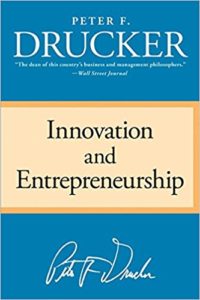Innovation and Entrepreneurship by Peter F. Drucker
“Innovation is the specific instrument of entrepreneurship…the act that endows resources with a new capacity to create wealth.”
― Peter F. Drucker
This book presents innovation and entrepreneurship as a practice and a discipline. It does not talk of the psychology and the character traits of entrepreneurs; it talks of their actions and behavior.
It is a practical book, but it is not a “how-to” book. Instead, it deals with the what, when, and why; with such tangibles as policies and decisions; opportunities and risks; structures and strategies; staffing, compensation, and rewards.
 Druker in his book says , “It has become almost a cliché for historians of technology that one of the great achievements of the nineteenth century was the “invention of invention.” Before 1880 or so, invention was mysterious; early nineteenth-century books talk incessantly of the “flash of genius.” The inventor himself was a half-romantic, half-ridiculous figure, tinkering away in a lonely garret. By 1914, the time World War I broke out, “invention” had become “research,” a systematic, purposeful activity, which is planned and organized with high predictability both of the results aimed at and likely to be achieved. Something similar now has to be done with respect to innovation. Entrepreneurs will have to learn to practice systematic innovation.
Druker in his book says , “It has become almost a cliché for historians of technology that one of the great achievements of the nineteenth century was the “invention of invention.” Before 1880 or so, invention was mysterious; early nineteenth-century books talk incessantly of the “flash of genius.” The inventor himself was a half-romantic, half-ridiculous figure, tinkering away in a lonely garret. By 1914, the time World War I broke out, “invention” had become “research,” a systematic, purposeful activity, which is planned and organized with high predictability both of the results aimed at and likely to be achieved. Something similar now has to be done with respect to innovation. Entrepreneurs will have to learn to practice systematic innovation.
Successful entrepreneurs do not wait until “the Muse kisses them” and gives them a “bright idea”; they go to work. Altogether, they do not look for the “biggie,” the innovation that will “revolutionize the industry,” create a “billion-dollar business,” or “make one rich overnight.” Those entrepreneurs who start out with the idea that they’ll make it big—and in a hurry—can be guaranteed failure. They are almost bound to do the wrong things. An innovation that looks very big may turn out to be nothing but technical virtuosity; and innovations with modest intellectual pretensions, a McDonald’s, for instance, may turn into gigantic, highly profitable businesses. The same applies to no business, public-service innovations.”
He further adds, “Systematic innovation means monitoring seven sources for innovative opportunity. The first four sources lie within the enterprise, and are are highly reliable indicators of changes that have already happened or can be made to happen with little effort. These four source areas are:
- The unexpected—the unexpected success, the unexpected failure, the unexpected outside event;
- The incongruity—between reality as it actually is and reality as it is assumed to be or as it “ought to be”;
- Innovation based on process need;
- Changes in industry structure or market structure that catch everyone unawares.
The second set of sources for innovative opportunity, a set of three, involves changes outside the enterprise or industry:
- Demographics (population changes);
- Changes in perception, mood, and meaning;
- New knowledge, both scientific and non-scientific.”
Intriguing indeed ! If these lines intrigued you as well and you want to know more about theses 7 sources in detail to understand Innovation and Entrepreneurship , then wait no more and grab your copy of Innovation and Entrepreneurship by Peter F. Drucker
You can buy the book from
http://www.amazon.in/Innovation-Entrepreneurship-Peter-F-Drucker/dp/0060851139











Your website is fantastic, I just found your website at Yahoo, I am interested to learn more. Hope it works out for me. Thank You.
I relish, cause I discovered exactly what I used to be
having a look for. You’ve ended my four day long hunt! God Bless
you man. Have a nice day. Bye
I am sure this post has touched all the internet visitors, its
really really nice piece of writing on building up new weblog.